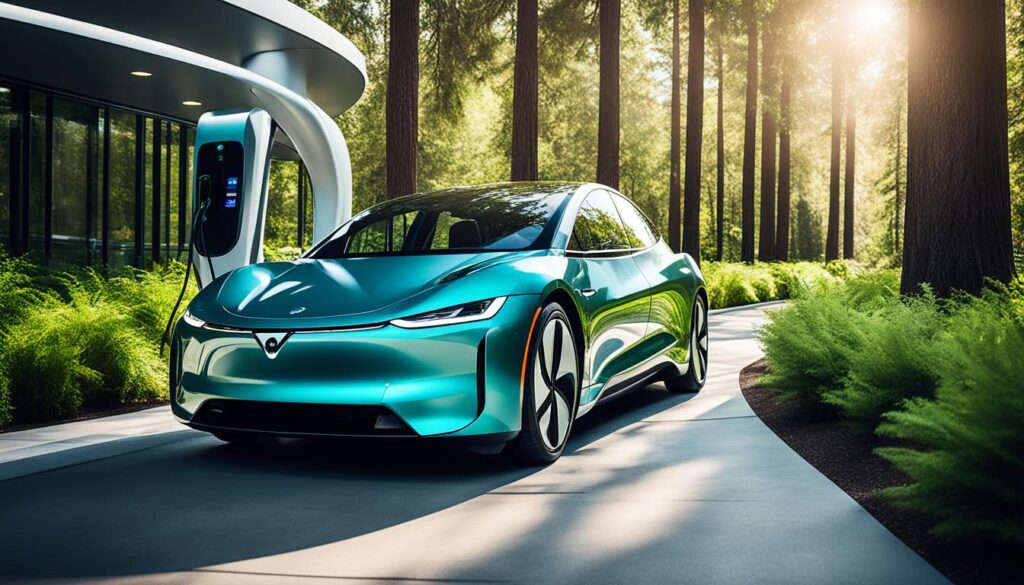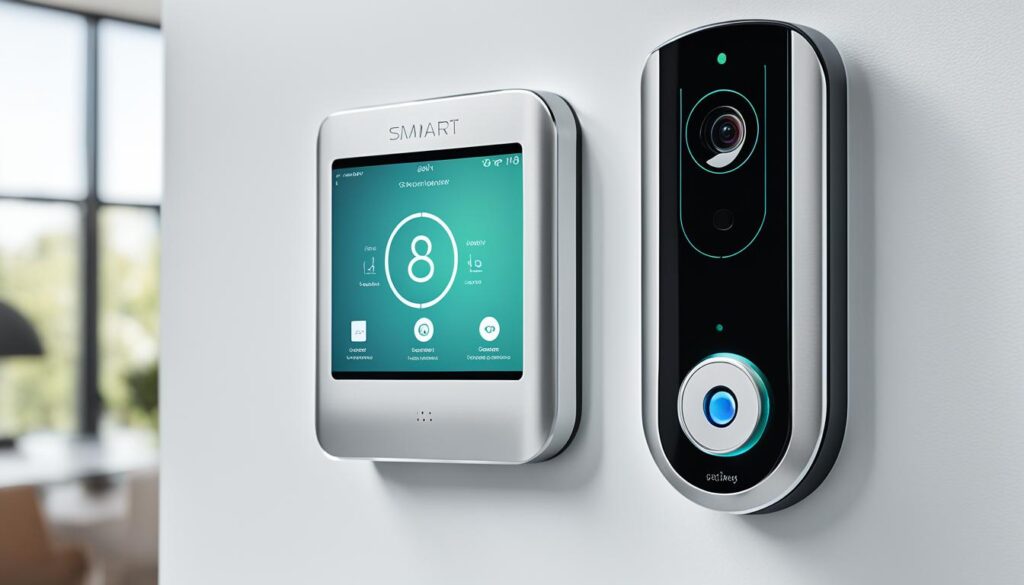The future of living sustainably is now possible thanks to smart home energy solutions. The ENERGY STAR program highlights systems that cut down on energy.1
These solutions often start with a smart thermostat, lighting, and plug load controls. Yet, they can include even more, like smart appliances and security. This blend helps create a unique, efficient smart home.1
With features like intelligent scheduling and energy-saving tips, homeowners can lower their energy use. SHEMS aims to make living sustainably easier for everyone.1
Key Takeaways
- ENERGY STAR SHEMS packages offer a comprehensive solution to simplify, reduce, and manage energy consumption in smart homes.
- Smart home devices can be customized beyond the minimum requirements to fit individual needs and preferences.
- SHEMS leverages automation, scheduling, and occupancy-based control to optimize energy usage and promote energy efficiency.
- Integrating renewable energy sources and storage solutions can further enhance the sustainability and cost-saving potential of smart home energy management.
- Leveraging smart home technology can lead to significant reductions in energy consumption and utility bills, contributing to a more eco-friendly and cost-effective lifestyle.
Introduction to Home Energy Management
Today, home energy costs are high and changing frequently. More people are using electric cars and heat pumps.2 Homeowners can now make some of their own energy. They do this by using their own devices to create electricity.2 Home Energy Management Systems (HEMS) help them control how much energy they use. This helps them save money and use energy in a better way.2
HEMS can be simple, like one device, or more complex, like systems that change with the weather and the prices of energy.2 These systems can lower energy costs up to 30%.2
Understanding the Importance of Energy Conservation
Buildings use 41% of all energy in the U.S. This shows how crucial it is to save energy in buildings.3 You can get Home Energy Management Systems (HEMS) for free or little cost. This makes it easier for people to use them.3 Special software called BEMOSS helps small and medium businesses use energy smarter.3 It aims to use less energy, use energy better, and help when the energy supply is low.
Benefits of Smart Home Energy Management Systems
HEMS are key in making homes use energy more efficiently and be better for the environment.2 They also help manage when and how electric cars charge. This keeps energy available for other needs at home.2
In a HEMS setup, you have things like batteries and smart meters. You also need special software. This software does things like look at how much energy you use and find ways to save.2 By using advanced technology, like AI, these systems can get even better at saving energy.2
When people use HEMS, they can see how they are using energy. This makes it easier to use less and help the planet.2
One company found that using a smart energy system made charging electric cars 20% cheaper.4 These energy systems help lower energy bills by using more renewable energy.4
The system by Enode makes it easy to connect electric cars, solar panels, and more.4 It can manage all these devices from one app. This means it’s easier to control your energy use.4
With this system, you can look at how much energy you used before. You can also see when it’s cheaper to use energy.4 You can set up your devices to use energy smarter. This can save you money.4
Home Energy Management
Home Energy Management Systems (HEMS) offer great benefits to users. They help manage energy use, cut costs, and make it easier to pay energy bills. HEMS also opens new opportunities for companies.5 These systems come in various types. They can control many home devices to save energy and money.
The foresee™ software is one of these advanced HEMS tools. It’s designed to save between 5% and 12% on energy bills for homeowners.5 If every U.S. home used foresee, we could save a lot of energy every day. This would lead to $10 billion in energy bill savings each year.5 foresee also helps relieve strain on the power grid by managing when appliances use energy.5 This software can adjust to high or low energy needs and even talk to the power company to get the best deal for homeowners.5
There’s also the Energy Manager software, created by Martin Weiss and his team. It aims to help homes use up to half of energy they need with their own power.1 If you add a battery at home, this can go up to 70%.1 A typical family using solar panels and a battery might not need more power.1 Weiss started working on the Energy Manager in 2016 at Bosch. He’s trying to make solar energy more popular and lessen the world’s use of fossil fuels.1
Both foresee and the Energy Manager show us what HEMS can do. They lower energy bills, promote green living, and cut our reliance on traditional energy. As we move forward with smart homes, these HEMS will become key. They’ll help us all use energy smarter and live in more efficient, affordable, and eco-friendly homes.

Key Components of a Smart Home Energy Management System
Smart home technology has changed how we handle energy at home. A smart home energy management system (SHEMS) is at the center of this change. It provides ways for homeowners to control energy, saving money and the planet.
Smart Thermostats
Smart thermostats are vital in a SHEMS. They adjust the temperature to use energy more wisely based on who is at home or the time of day.6 These devices use very little energy when not in use, about 3.0 watts.6 With smart thermostats, you can change or schedule your home’s temperature even when not at home. This makes managing your energy use simple.
Smart Lighting Systems
Lighting is another important part of a SHEMS. Smart lights bring convenience, automation, and help in saving energy.6 Smart light switches in the system use little energy when off, only about 0.5 watts.6 There’s also a mode that uses very little power if no one’s home, saving more energy.
Energy Monitoring Devices
Monitoring your energy use closely is key in a SHEMS. This job falls to devices like smart panels and consumption trackers.7 They give detailed info on when and where your energy goes. This knowledge helps you use energy smarter.7 The system’s app works on all kinds of devices. This makes it easy to check your energy use anytime, anywhere.
By using smart thermostats, lighting systems, and monitoring devices, a SHEMS helps you manage your energy better. You save money and have more say in how energy is used at home.
Energy Efficiency and Cost Savings
Using energy efficiency saves money for homeowners. Smart home technology like HEMS helps a lot. With HEMS, you can manage your energy use better. This leads to big energy savings and lower utility bills.
Reducing Energy Consumption
HEMS makes it easy to save energy. It shows you how much electricity you use in real time. This info helps you find ways to use less. For example, fixing drafts and getting better windows can save 5% to 30% on power each year.8 HEMS also control how much energy your devices use. They make sure everything is as efficient as possible.
Lowering Utility Bills
HEMS doesn’t just save energy, it cuts utility bills too. For instance, using a programmable thermostat can save 10% on heating and cooling. Better heating and cooling systems can cut use by 20% to 50%.8 Also, ENERGY STAR homes use at least 10% less energy. They’re about 20% better on average. This means smaller bills for those who live in them.9
| Energy-Efficient Measure | Potential Energy Savings |
|---|---|
| Reducing drafts in the home | 5% to 30% per year8 |
| Installing storm windows | 25% to 50% reduction in heat loss through windows8 |
| Using programmable thermostats | Up to 10% annual savings on heating and cooling bills8 |
| Upgrading heating and cooling systems | 20% to 50% reduction in energy use for heating and cooling8 |
| ENERGY STAR certified homes | At least 10% more energy efficient than homes built to code, 20% improvement on average9 |
HEMS is a powerful tool for homeowners. It makes energy efficiency and cost savings easy. This leads to a more sustainable and affordable life.

Integration with Renewable Energy Sources
The use of renewable energy sources is on the rise, like solar power. It’s key to link these green solutions with home energy management systems. These systems help spread and use renewable energy at home, letting owners get the most from their generated power.10
Solar Power Integration
Home energy management systems work well with solar power. They help use the solar-generated electricity at home first. This way, you use less electricity from the grid. Plus, you can regulate your energy use and maybe even cut down on your bills.10
Battery Storage Solutions
Home energy management can also join forces with battery storage. This lets you save extra solar power for later, like when you need more energy or the sun isn’t out. By doing so, you can rely more on your own energy, join grid services, and market energy.10
Bringing in renewable sources and HEMS is a big move towards eco-friendly and efficient home energy. More clean energy is joining power grids. This means HEMS will be even more important in using and sharing the clean energy stash. It helps everyone from homeowners to the bigger energy world.1011
Automation and Convenience
Smart home energy management systems (HEMS) offer a level of convenience that was not possible before.12 They let homeowners set schedules to control when devices like thermostats, lights, and appliances work. This way, home energy use is optimized.12 You can also control your home’s energy from anywhere using HEMS. This adds a whole new level of convenience and control.12
Scheduling and Remote Control
HEMS lets you set up custom schedules for your smart devices. You can make sure things like heating, cooling, and lights are only on when needed.12 This scheduling cuts down on energy waste, saving you money over time.12 Plus, you can change your home’s energy settings from your phone. This gives you the freedom to manage energy use even when you’re not home.12
Voice Control and Smart Home Integration
Adding voice control to HEMS makes managing your home even easier.12 You can control energy systems simply by talking. This includes adjusting the thermostat, turning off lights, or shutting down appliances.12 With voice commands, you get a hands-free way to manage energy. This makes everything about your home more accessible and easier to use.12
Fully integrating HEMS into a smart home means you can control everything from lights to security systems in one place.12 This brings your smart home together under one system.12 By working together, these devices create a smart, energy-efficient home.12

Home Energy Management Solutions Providers
The home energy management market is booming with various players. This includes energy giants, tech companies, and smart home designers. All aim to meet the changing needs of homeowners with their specific skills. They offer advanced solutions for managing home energy efficiently.
Energy Retailers and Utility Companies
Energy sellers and utility firms find an easy fit in the HEMS market. Their deep knowledge and big customer base help. They provide tools that make managing energy and saving money easy for homeowners. This helps the environment and makes customers happier.
Technology Companies and Smart Home Ecosystems
Companies like13 Nest Labs, Inc. and13 Alphabet Inc. (Google’s parent) stand out. They’re adding AI and IoT to home energy products. These innovations make running your home more efficient and eco-friendly.
In Europe, tech giants like Thales and local firms are stepping up energy tech. They offer everything from smart meters to solar solutions. This mix of big and small companies builds a smarter, greener home.
In the U.S., companies like Verdigris and Span are changing how we power our spaces. They help big buildings and homes be smart about energy. This keeps energy costs down and pollution low. Now, there are even electric vehicles and buses specially designed for growing cities in places like Kenya.
Over half of solar homes use a HEMS too. These systems help make the most of solar energy and cut costs. With more people using electric cars and heaters, the need for HEMS is climbing. Families using HEMS lower their bills and help the planet, with 30% less energy used and 25% less carbon.
Smart Home Energy Management for Electric Vehicles
As more people switch to electric vehicles (EVs), they want to find ways to make these cars a part of their smart homes. Smart home energy management systems (HEMS) are key for this. They help balance the home’s power needs with what electric cars need to charge.14
EV Charging Management
HEMS are great for managing how and when EVs charge. They look at things like when energy is cheapest and the state of the local power grid.14 This makes charging EVs fit better with the overall energy use of the house. It also helps keep the power grid stable and efficient.
Vehicle-to-Grid Technology
But HEMS can do more than manage charging. They can use a technology called vehicle-to-grid (V2G). This lets EVs give back electricity when there’s high demand or power outages.
V2G turns EVs into small power storage systems. This gives homeowners more ways to manage their energy use and save money. It also helps keep the local power grid strong.14

Making electric vehicles a part of smart homes is a big step for green living. With HEMS, homeowners can include their EVs in their energy plans. This brings big benefits like saving money and helping the environment.14 Plus, as technology gets better, EVs and HEMS will be even more important for smart homes. They will help homeowners have more say in their energy use.
Ford and Resideo’s EV-Home Power Partnership project
is proof that HEMS and EVs can boost how we manage home energy.
Security and Privacy Considerations
Smart home energy management systems (HEMS) gather a lot of15 energy data. It’s vital to think about smart home security and data privacy. Owners need to know their info and energy use data are safe from harm.15 HEMS providers must use strong cybersecurity and obey privacy laws. This keeps the smart home system safe and private.
Consumers should be able to control who sees their energy use details. The15 privacy of this info is key for everyone who uses electric services.15 To share any info with others, customers should say it’s okay first.15 And laws have to say when companies can give out data.
15 Rules should make sure others also keep the shared data safe.15 The design of smart homes should keep consumer privacy in mind.15 They should let users know what’s happening with their data. This includes who owns the data and how it’s kept private.
15 “Knowing and being flexible about Smart Grid tech is very important long-term.”
15 Smart Grid tech collects a lot of info on energy use. This info needs to be kept private.15 Electric companies need access to this data to manage networks and do billing.15 When using Smart Grids, it’s important to remember everyone’s needs. This includes those in rural areas, low-income families, minorities, and the elderly. They all need fair access and their privacy protected.

Future Trends and Advancements
The smart home world is always changing. Now, artificial intelligence (AI) and machine learning (ML) are becoming key players. They help home energy systems (HEMS) learn from how we use energy. This way, they can predict our needs better, give us advice tailored to our habits, and even handle energy on their own.16
Artificial Intelligence and Machine Learning
AI and ML are making HEMS much smarter. They’re starting to understand what our homes really need in terms of energy. This tech makes it easier to predict renewable energy availability, manage how we respond to rising or falling energy demands, and do even more intelligent tasks. As a result, running our homes more efficiently and conveniently is on the horizon.16
Internet of Things (IoT) and Edge Computing
Soon, the Internet of Things (IoT) and edge computing will change energy management at home too. The IoT, which means all our smart devices can talk to each other, and edge computing will work together to gather and analyze energy data fast. This will allow for instant feedback and smart actions taken in real-time.16 Also, by doing more thinking on the device itself, our energy systems will work faster and stay reliable without leaning too heavily on the internet.16
The path smart home energy is taking looks very promising. Many households already have 17 devices that connect to the internet. Plus, almost half in the U.S. see smart tech as a must in their homes.17 By blending AI, ML, IoT, and edge computing, we’re heading towards big energy savings, better convenience, and smoother living for all.17 Imagine a home that always adjusts to fit your needs using the latest in smart tech. That’s where we’re headed.16

Getting Started with Home Energy Management
Starting a more energy-efficient and cost-effective home begins with knowing your current energy needs. Look into smart home solutions to match your needs.18 This ensures the system you pick meets your goals for saving energy and money.
Assessing Your Home’s Energy Needs
Know your home’s energy use before you add a HEMS. Understand your devices and what you need from your energy setup.18 This helps pick the right HEMS for your home. Think about your family’s energy use, any solar panels, and big items like EVs or heat pumps.
Choosing the Right Smart Home Solution
With your home’s energy use in mind, look at what HEMS options there are.18 These can include basic to advanced platforms. Ensure the one you choose fits your goals for managing home energy.

By evaluating your home’s energy needs and HEMS, you’re making a smart choice. This decision will lead to a better, more efficient home. It’ll save you money and help the environment.18
Conclusion
Home energy management solutions can change how we use energy at home. They allow for more efficiency, saving money, and being kind to the planet. These systems use smart gadgets, renewable energy, and smart ways to control usage. They help people cut down on energy waste, lessen their impact on the environment, and manage their energy bills better. New technology promises to bring even cooler ways for us to be green and efficient at home.
In 2019, China used 7,225.5 billion kWh of electricity. This was a 4.5% jump from the year before. Urban and rural homes used 1,025 billion kWh, which is 14.2% of the total.19 On the other hand, in the U.S., homes and businesses used 72% of the electricity. At least 30% of this was viewed as waste.19 This shows how much we can save by managing our energy better.
The use of smart technology in homes is growing fast. This means HEMS will have new chances but also face some issues.19 Many experts are looking into ways that Home Energy Management Systems (HEMS) can help. They see a big benefit in these systems working together with electricity systems. This can help avoid wasting energy and lower costs.19 Thanks to new systems, like smart meters and smart networks, homes can now respond to energy needs in smarter ways. This helps lower energy use and cuts costs for homeowners. By using these smart home gadgets, we can make our homes greener and save money too.
FAQ
What is an ENERGY STAR Smart Home Energy Management System (SHEMS)?
The ENERGY STAR SHEMS program recognizes smart systems for homes. These systems help simplify, reduce, and control energy use. A package includes an ENERGY STAR smart thermostat, lighting, and plug load monitor. You can also add ENERGY STAR appliances, EV chargers, and smart security.
How can Home Energy Management Systems (HEMS) help homeowners?
HEMS can help homeowners manage their energy use. This may lower their energy bills by up to 30%. They are valuable for optimizing energy use, making tasks automatic, and reducing energy costs.
What are the key features and capabilities of HEMS?
HEMS have several features. They include controlling the thermostat smartly and showing energy use in real-time. They also give suggestions for saving energy. They can automatically control devices, work with solar panels, and manage EV charging.
How do energy retailers and utility companies benefit from HEMS?
By offering HEMS, energy sellers and providers can make customers more loyal. This also helps these companies offer more services beyond just selling energy.
What are the security and privacy concerns with HEMS?
Since HEMS gather lots of data, there are important security and privacy issues. HEMS makers must use strong cyber security. They have to follow privacy rules to keep smart homes safe and private.
How can AI and machine learning enhance HEMS capabilities?
AI and ML can make HEMS smarter. They can learn from how people use energy. This leads to better suggestions and automatic decisions for managing energy.
How should homeowners approach implementing a home energy management system?
Homeowners should look at their energy use, devices, and needs before getting a HEMS. This helps find the best HEMS to save energy and money.
Source Links
- https://www.bosch.com/stories/smart-home-energy-management-system/
- https://sustainabilityknx.org/articles/a-guide-to-home-energy-management-systems-hems/
- https://www.osti.gov/servlets/purl/1423114
- https://enode.com/use-cases/home-energy-management
- https://www.nrel.gov/buildings/foresee.html
- https://www.energystar.gov/products/shems_key_product_criteria
- https://www.energysage.com/energy-management/components/
- https://www.energy.gov/energysaver/why-energy-efficiency-matters
- https://www.energystar.gov/about/how-energy-star-protects-environment/energy-efficiency
- https://www.nrel.gov/grid/renewable-energy-integration.html
- https://www.ren21.net/gsr-2021/chapters/chapter_06/chapter_06/
- https://medium.com/@luke.ryanix/empowering-homes-the-rise-of-home-automation-and-smart-energy-management-eda2e1e529df
- https://www.imarcgroup.com/top-home-energy-management-systems-companies
- https://media.ford.com/content/fordmedia/fna/us/en/news/2023/12/07/ford-and-resideo-launch-ev-home-power-partnership-project-drivin.html
- https://www.energy.gov/gc/articles/department-energy-data-access-and-privacy-issues-related-smart-grid-technologies
- https://eliq.com/blog/the-future-of-smart-home-energy-7-insights-and-trends/
- https://www.forbes.com/sites/jennifercastenson/2024/01/17/hot-housing-innovations-at-ces-reimagine-smart-energy-use/
- https://www.gridx.ai/knowledge/home-energy-management-system-hems
- https://www.frontiersin.org/articles/10.3389/fenrg.2021.772027
